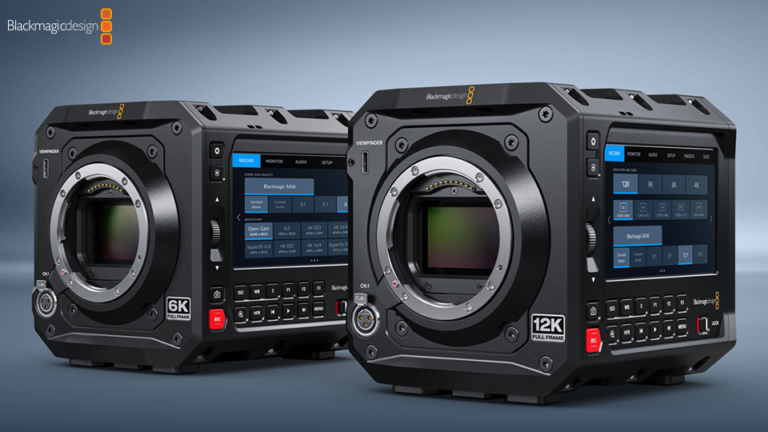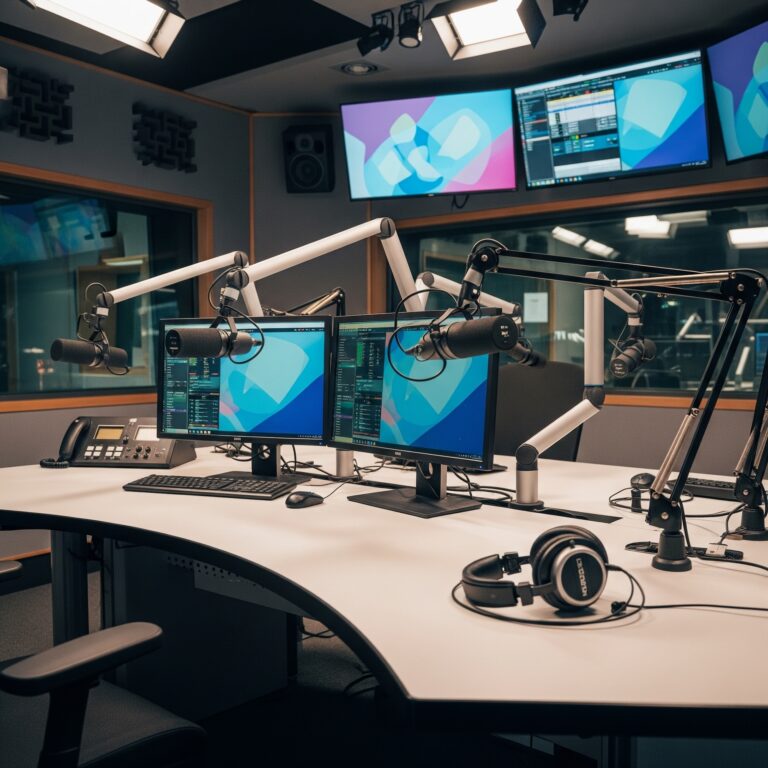The Ultimate Wish List: My Dream ATEM Upgrades That Would Break the Broadcast World (and Budgets)
Let’s be honest, trying to keep up with Blackmagic Design’s relentless pace of innovation can feel like running a marathon in flip-flops. Just when you’ve mastered one piece of kit, they drop a stack of firmware updates or a new camera that makes your head spin (and your wallet groan). We love them for it, of course—they keep the entire industry on its toes!—but sometimes, a guy just has to pause and wonder: what if I could write the feature list? What if I could tell the engineers exactly what I need to solve the knottiest problems in live production?
This post is exactly that: my personal wish list. This is not an official announcement, and it’s certainly not a leak! It is the conceptual blueprint I’ve drawn up—the ultimate ATEM live production ecosystem that exists only in my own head right now. I’ve spent far too many late nights designing the perfect schematic, the system that finally makes sense of the chaotic, hybrid nature of modern broadcasting, and now I’m sharing it with you.
The reality is, live production has become terrifyingly complex. We’re dealing with massive input counts across both traditional SDI and the thorny transition to IP video (where every cable looks the same but carries a completely different-sounding protocol). We also have the overwhelming need to record everything for post-production and archives, putting serious pressure on system capacity. The system I dream of starts with a truly monstrous core architecture—a switcher built to handle an unprecedented scale of I/O, recording, and processing power that would make any technical director’s heart race.
But sheer scale is only half the battle. A massive switcher is useless if I can’t run it efficiently, which is why I’ve focused heavily on control. My anxiety levels just drop by 10% when I think about a control surface that is truly intuitive. I’m dreaming of an ATEM Advanced Panel upgrade that becomes a hyper-aware command centre. This is a panel smart enough to manage every single recorder built into the system, offering dedicated, physical control over every file and every start/stop command. I want LCDs that dynamically label and simplify the complex routing of new IP sources, taking the guesswork out of the control room.
And who can forget the critical corners of the control room: colour and sound? The current workflow for camera shading often feels piecemeal, especially when I’m trying to match multiple cameras quickly and precisely. My wish list includes an upgraded ATEM Camera Control Panel that staples a professional colour suite right onto the hardware. This would give the shader dedicated, tactile control not just over the basics (Iris, Black, Gain), but over the kind of advanced secondary colour tools that usually require a separate system.
Finally, my audio-obsessed heart demands better. Bad audio is worse than bad video, and for too long, the live audio engineer has been left relying on awkward software or non-integrated third-party controllers. My dream includes the ATEM Fairlight Live Console: a purpose-built physical surface that completely integrates professional-grade audio mixing into the ATEM ecosystem. I’m talking about motorised faders, deep access to EQ and dynamics, and a solution that finally unifies the headache of digital audio patching, like Dante and MADI, onto a single surface.
It’s exciting to see a concept that finally gives live sound, camera shading, and video switching the high-end, dedicated hardware they deserve, completely integrated within a single ecosystem. I think these conceptual upgrades would be pure gold. So, let’s dive into the four areas of this dream machine and see exactly what features I’m wishing for.
1. The Core Beast: ATEM System Architecture Upgrades
Alright, now that we’ve established this is my own personal fever dream, let’s start with the heart of the beast: the switcher itself. If we’re going to build the ultimate system, we need an unprecedented level of I/O and processing muscle. This is where the magic number of inputs and outputs stops being a hypothetical wish list and becomes a terrifying, wonderful reality.
My wishlist for the core ATEM upgrade focuses on massive expansion and built-in efficiency:
- Connectivity That is Just… Bonkers: We’re talking about an absolutely terrifying amount of I/O. The dream system would support up to 80x 12G SDI or 10G ST2100IP (Ethernet) Inputs. The best part? It would have standards conversion available on every single input, which is a lifesaver when you’re dealing with mixed frame rates (my brain also starts to fog over trying to match them manually!). On the way out, you get equally huge support for up to 48x 12G SDI and 48x 10G ST2110IP (Ethernet) outputs, that also have standard conversion as standard.
- Recording Power for the ISO Obsessed: Say goodbye to endless stacks of external recorders for everything. This solution would feature eight built-in HyperDeck recorders. Along with that, we’d get internal M.2 recording. This would allow for recording to of programme/clean feeds and selected inputs in H.264, H.265 or ProRes. These additional built-in HyperDeck recorders/players also enable playback of VT or on-screen graphics and you can even use DVE effects to place bugs and lower thirds.
- Dante, Finally Getting Cozy: My audio-obsessed heart is singing because the I/O would offer up to 298 channels of audio via embedded SDI/MADI and dedicated Dante Audio Networking support. Crucially, Dante is supported over it’s own Ethernet network, which provides expanded I/O and simplified digital audio routing.
- Keyers and Effects for Days: If you’ve been waiting for more muscle for your on-air look, you’ve got it. The system would keep the four Motion Encoding (M/E) rows, and increate the count of the Advanced Chroma Keyers to 20, the Digital Video Effects (DVEs) to eight, and bump the two SuperSource processors to four. It also utilises the M.2 storage to enable more complex animated graphics, enable onboard replays and provide video wall processing.
This is the foundation. It’s the engine room that enables the real-world operational improvements we’re looking for in the control surfaces we’re about to discuss!
2. The Physical Magic: ATEM Advanced Panel Upgrades
You know that feeling when you try to do something complex on a tiny touchscreen? My back is grateful just thinking about a control surface that is truly intuitive. If the core ATEM is the beast, these conceptual upgrades turn the ATEM Advanced Panel into a hyper-aware, intelligent command center, reducing the cognitive load immensely.
My dream panel focuses on making complex IP routing and file management feel simple:
- Switching Control (The Essentials): Obviously, we keep the non-negotiables: the dedicated Program/Preview/Aux bus for programme and preview switching, a T-Bar fader, and buttons for keyers and transitions. The dream system also features configurable Aux switching.
- IP Integration & Dynamic Labels: This is where the panel gets smart! To handle all that scary IP video, the system would feature Input Labelling. This enhances system control with dynamic LCDs and labels, clearly displaying and routing those confusing inputs and sources. No more guessing which Ethernet or SDI cable is carrying which feed, and an end to sticking LX tape all over your console
- HyperDeck Control Right on the Panel: Remember those built-in HyperDeck recorders and the internal M.2 ISO recording? The expanded recorder control panel would feature dedicated functions and soft buttons for assigning and controlling those built-in HyperDeck units. It would also manage the internal M.2 ISO recording functionality, including start, stop, and file naming.
- The Fairlight Handshake: They’d build in a menu-driven system control LCD that lets me access, select, and adjust audio channels EQ and dynamics. It would even offer limited hardware-only fader control. Crucially, Integrated Fairlight Control would provide a dedicated mode and software linkage for seamless integration and control via the new ATEM Fairlight Live Console. You read that right a sprat Firelight Live Console, more on that in a mo. This would mean the Panel can focus purely on video while the Console handles audio.
- Media/Macro Control: This comprehensive setup includes dedicated buttons for transition control, a joystick for DVE manipulation, and menu access to media players and macros.
This redesigned panel would take the technical stress out of managing a massive, hybrid IP/SDI system, making everything behave the same no matter the input.
3. The Colour Command Post: ATEM Camera Control Panel Upgrades
If you’re running a huge show, a single operator needs to be able to paint every camera from a dedicated panel, and I need all the help I can get making my cameras match, and the standard CCU functions sometimes feel tighter than my jeans after Christmas dinner.
These conceptual upgrades would basically staple a professional colour correction suite onto a standard CCU panel, giving the camera shader surgical precision:
- Beyond Four Cameras (Finally!): While the panel would still offer Full CCU Control with a dedicated joystick, knobs, and buttons for iris, Black, Gain, Shutter, and White Balance on up to four cameras, it would introduce Expanded CCU Banks. This brilliant bit of engineering lets you manage up to eight or twelve cameras via bank switching, similar to M/E bus expansion, making it fully compatible with the larger Constellation input capacities we outlined earlier.
- Primary and Secondary Colour Correction: This is the game-changer for shading control. You’d get dedicated knobs for Lift, Gamma, and Gain control, serving as a primary colour corrector for real-time colour matching between cameras. And wait for it… it would include an integrated advanced colour system with a dedicated hardware control panel for secondary colour correction functions like HSL qualification, Luma, and Saturation control! That’s like having DaVinci Resolve’s colour page at your fingertips, live! You also have the option to only have the colour correct on the live feed and not on any ISO recording so the colourist in post doesn’t have a heart attack when they see what you have done to the raw footage.
- True Hybrid Studio Support: The system integration would enhance the standard Ethernet connection for IP/Tally integration with enhanced protocol communication. This would natively manage Tally and controls data over both SDI and ST 2110 IP links, which is a huge benefit for improving compatibility with hybrid studio setups—a massive benefit when you’re mixing old and new tech.
This is the kind of control that stops a camera match from being a stressful guess and makes it a repeatable, professional workflow.
4. Audio Meets Video: ATEM Fairlight Live Console (New Product Concept)
Look, I’m a video person, but even I know that bad audio is worse than bad video. For too long, the live audio engineer has been left relying on awkward software or non-integrated third-party controllers, which is just not good enough when you’re managing complex live sound. This ATEM Fairlight Live Console concept is the ultimate dream of bringing true, professional audio mixing directly into the ATEM ecosystem.
The Dream of Deep Tactile Control: This console, which I have probably spent far too long modelling in blender for this posts thumbnail, would be a dedicated physical control surface, offering true Deep Fairlight Control. It would be equipped with high-quality motorised faders, assignable encoders, and a custom user interface. The console’s entire purpose is to manage the Constellation’s Fairlight mixer , providing the tactile professional workflow needed for real-time complex audio mixing. Crucially, this setup eliminates reliance on software or a non-integrated third-party MIDI/Mackie panel, giving audio engineers the focused hardware they deserve.
Instant Access and Scale: The console would be designed for speed and scale. Dedicated channels would offer instant access to six-band EQ parameters, dynamics, panning, Aux sends, and the all-important mix-minus setup. This Direct Access allows audio operators to quickly adjust multiple parameters simultaneously, which is absolutely essential in a fast-paced live environment. Better yet, the console would be capable of managing large channel counts of up to 156, proving it’s built for the massive I/O capacity of the core switcher.
Unifying the Digital Audio Maze: One of the biggest headaches in modern broadcast is digital audio networking. The console would include a hardware routing control section for visually managing and routing signals to and from Dante and MADI network ports. This simplifies the workflow dramatically by unifying all digital audio patching within the ATEM ecosystem onto a single purpose-built surface. No more messy external routing software!
All-in-One Monitoring and Talkback: Finally, operational efficiency is boosted by an integrated monitoring system. This system would boast high-resolution screens for detailed channel metering, EQ curves, and routing graphs, mean the performers can get what they need in their wedges or IEM. It even features a built-in talkback, ensuring the audio engineer has communication with the Technical Director right at their fingertips. This all-in-one solution significantly improves operational efficiency for live audio engineers.
The Ultimate Dream Machines
So there you have it: the blueprint for my ultimate, no-holds-barred ATEM system. This isn’t just about bigger inputs, either. This dream is about smarter, more integrated control—from the way the switcher natively manages IP inputs and HyperDeck recorders on the Advanced Panel, to the ability to perform secondary colour correction right from the camera controls. And, thank goodness, the inclusion of a dedicated Fairlight Live Console finally gives audio the first-class hardware treatment it deserves.
This conceptual system, built around a core of massive I/O capacity and specialized control surfaces, would eliminate so many of the technical headaches we face every day in a hybrid production environment. My back would certainly be grateful!
Now, the important part: What do you think is the most game-changing dream feature on this list? Is it the massive scale of the core I/O? Or is it the peace of mind offered by unifying Dante and MADI routing on the Fairlight Console? Or do you think I have missed out something entirely? let me know in the comments of the post that brought you here. Maybe, just maybe Blackmagic might see this and take some ideas on board… or at least give us an explanation to why we are still missing Dante after all this time!







